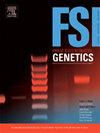法医体液鉴定tsRNAs的定量差异分析:基于上皮细胞液筛选的rt - qpcr鉴别
IF 3.1
2区 医学
Q2 GENETICS & HEREDITY
引用次数: 0
摘要
鉴定犯罪现场的体液类型是法医学的一个关键步骤,为刑事调查和解释证据提供必要的背景。表观遗传标记,特别是小非编码RNA (sncRNAs),在法医体液鉴定中引起了越来越多的关注,各种小RNA物种显示出作为区分不同体液类型的生物标记物的潜力。一类新的sncRNAs, trna衍生的小rna (tsRNAs),已经在各种生物样品中检测到,但它们在法医体液鉴定中的潜在应用仍未探索。在这项研究中,我们在唾液和阴道分泌物(两种上皮细胞来源的体液)中发现了差异表达的tsRNAs。采用茎环反转录和SYBR Green定量聚合酶链反应(RT-qPCR),以U6-snRNA为对照,测定tsRNA丰度。在实施质量控制措施以确保检测准确性和调整Cq值后,我们鉴定出10个在唾液和阴道分泌物中差异表达的tsRNAs。为了进一步研究tsrna在法医体液鉴定中的潜力,我们将分析范围扩大到精液、外周血和经血。我们的研究结果揭示了18种tsRNAs在这五种体液中具有显著差异的表达模式。通过将定量表达数据与逻辑回归机器学习模型相结合,9个tsrna的面板在留一交叉验证中达到了98% %的准确率。虽然我们的研究结果表明tsrna作为法医体液鉴定的生物标记物具有很大的潜力,但额外的体液特异性tsrna可能会提高预测的准确性,同时可能减少所需标记物的数量。这一初步验证确立了tsrna作为法医体液鉴定应用的有价值候选者。本文章由计算机程序翻译,如有差异,请以英文原文为准。
Quantitative differential analysis of tsRNAs for forensic body fluid identification: RT-qPCR-based discrimination derived from epithelial cell fluids screening
Identification of body fluid types at crime scenes is a critical step in forensic science, providing essential context for criminal investigations and the interpretation of evidence. Epigenetic markers, particularly small non-coding RNAs (sncRNAs), have attracted increasing attention in forensic body fluid identification, with various small RNA species demonstrating potential as biomarkers for distinguishing different body fluid types. A novel class of sncRNAs, tRNA-derived small RNAs (tsRNAs), has been detected in various biological samples, yet their potential application in forensic body fluid identification remains unexplored. In this study, we identified differentially expressed tsRNAs in saliva and vaginal secretions, two epithelial cell-derived body fluids. Using stem-loop reverse transcription followed by SYBR Green quantitative polymerase chain reaction (RT-qPCR), we measured tsRNA abundance with U6-snRNA as the reference control. After implementing quality control measures to ensure detection accuracy and adjusting Cq values, we identified 10 tsRNAs that were differentially expressed between saliva and vaginal secretions. To further investigate the potential of tsRNAs in forensic body fluid identification, we extended our analysis to include semen, peripheral blood, and menstrual blood. Our results revealed 18 tsRNAs with significant differential expression patterns across these five body fluids. By integrating quantitative expression data with a logistic regression machine learning model, a panel of 9 tsRNAs achieved 98 % accuracy in leave-one-out cross-validation. While our findings demonstrate the promising potential of tsRNAs as biomarkers for forensic body fluid identification, additional body fluid-specific tsRNAs would likely enhance prediction accuracy while potentially reducing the number of required markers. This preliminary validation establishes tsRNAs as valuable candidates for forensic body fluid identification applications.
求助全文
通过发布文献求助,成功后即可免费获取论文全文。
去求助
来源期刊
CiteScore
7.50
自引率
32.30%
发文量
132
审稿时长
11.3 weeks
期刊介绍:
Forensic Science International: Genetics is the premier journal in the field of Forensic Genetics. This branch of Forensic Science can be defined as the application of genetics to human and non-human material (in the sense of a science with the purpose of studying inherited characteristics for the analysis of inter- and intra-specific variations in populations) for the resolution of legal conflicts.
The scope of the journal includes:
Forensic applications of human polymorphism.
Testing of paternity and other family relationships, immigration cases, typing of biological stains and tissues from criminal casework, identification of human remains by DNA testing methodologies.
Description of human polymorphisms of forensic interest, with special interest in DNA polymorphisms.
Autosomal DNA polymorphisms, mini- and microsatellites (or short tandem repeats, STRs), single nucleotide polymorphisms (SNPs), X and Y chromosome polymorphisms, mtDNA polymorphisms, and any other type of DNA variation with potential forensic applications.
Non-human DNA polymorphisms for crime scene investigation.
Population genetics of human polymorphisms of forensic interest.
Population data, especially from DNA polymorphisms of interest for the solution of forensic problems.
DNA typing methodologies and strategies.
Biostatistical methods in forensic genetics.
Evaluation of DNA evidence in forensic problems (such as paternity or immigration cases, criminal casework, identification), classical and new statistical approaches.
Standards in forensic genetics.
Recommendations of regulatory bodies concerning methods, markers, interpretation or strategies or proposals for procedural or technical standards.
Quality control.
Quality control and quality assurance strategies, proficiency testing for DNA typing methodologies.
Criminal DNA databases.
Technical, legal and statistical issues.
General ethical and legal issues related to forensic genetics.

 求助内容:
求助内容: 应助结果提醒方式:
应助结果提醒方式:


